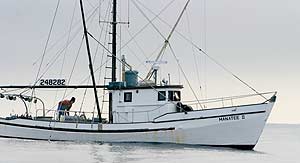|
http://www.theworldlink.com/articles/2007/02/07/news/news01a020707.txt
Salmon numbers
better than expected

|
|
Fall Chinook returns on the
Klamath River were higher than
expected last year, but the
preliminary total of 30,400
still fell below the 35,000
minimum threshold to allow for
a full commercial salmon
fishing season. World File
Photo |
Fall Chinook return
tops predictions by 8,000; coho
also are up sharply
February
7, 2007 By Susan Chambers,
Staff Writer
It's February - and the time of
year commercial salmon trollers
start thinking about prepping
their boats for another season of
bringing in Chinooks to sell.
Or maybe not.
Last year's disastrous season of
no fishing for much of the
Southern Oregon Coast already has
prompted a few fishermen to leave
the fishery altogether - and the
ones who remain are wary.
No federal money has drifted this
way. State money is gone. Moorage
and boat insurance bills are
coming due.
Yet the
estimates, the data, the meetings
continue like clockwork. Planning
for the upcoming season is getting
started and one of the key numbers
fishermen and managers look at is
the Klamath River fall Chinook
returns to the river.
A base of 35,000 adult natural
fish must return to the river in
order meet the requirements of the
fishery management plan - and
therefore allow future fishing.
Last fall, the escapement was only
about 30,400 fish, but those are
preliminary numbers. It's the
third year in a row that returns
have fallen below the 35,000-fish
floor.
But it's also more than managers
predicted in April. During a
grueling season-setting meeting in
Sacramento, managers tried to
allow some fishing north of
Florence while estimating that
about 22,000 fish would return.
The higher
actual returns put fishermen and
fishery managers in a quandary.
Fishery managers see improvement
in the population of fish.
Fishermen see salmon left on the
table that could have been caught.
“It's still below the 35,000
floor, but better than we
expected,” Oregon Department of
Fish and Wildlife Assistant Fish
Division Administrator Curt
Melcher said Tuesday.
Crafting estimates of fish returns
while trying to account for
several variables such as fishing
effort, natural predation and
ocean conditions, is an inexact
science.
“We don't know how the fishery
catch played into it,” Pacific
Fishery Management Council salmon
staff officer Chuck Tracy said,
“or whether it was something
else.”
The good news is that Oregon Coast
natural coho forecasts are high,
Tracy said. The returns of jacks -
2-year-old Klamath fall Chinook -
also was very good, managers said.
“About 21,000 total, which is a
lot,” Tracy said. “That's the most
since the mid-1980s.”
Calls for change
Charleston salmon troller and
Oregon Salmon Commission member
Jeff Reeves said Tuesday that the
increase of returns is good news,
but had fishermen been able to
catch another 8,000 fish - the
difference between the projected
returns and the actual returns -
the fleet would not have had to
struggle so much in 2006. The
8,000 Chinook would have meant
several thousands of dollars to
fishermen and communities.
“It's missed fishing opportunity,”
Reeves said.
Nonetheless, Reeves and other
fishermen are planning to request
a change in the season structure
at a series of meetings to be held
at various locations through April
(see sidebar, Page A1).
Reeves hopes fishery managers will
allow at least 100 fish a week,
with no restrictions on what days
can be fished, between the
Florence south jetty and Humbug
Mountain or between Florence and
Cape Arago. The other option would
be for 75 fish a week between the
Florence south jetty and Cape
Arago.
The state also is considering a
state waters fishery, if federal
managers close the season again,
at the request of the salmon
commission.
“We're committed to providing
state waters fisheries in waters
where there are healthy stocks,”
Melcher said.
Melcher said that much work still
has to be done, such as evaluating
the September and October
fisheries and getting results from
coded wire tag returns.
Hopes for better seasons
Federal fishery managers will be
compiling data and information
from several sources over the next
few weeks to determine how many
fish of each age group returned to
the Klamath. Many are hopeful
there will be a better season in
2007 than in 2006. And 2008 should
be even better.
The jacks convert to 3-year-olds
for the ocean fishery, Melcher
said, and the high returns of
jacks should translate to a a
great season in 2008, when the
fish are 4-year-olds.
That expectation likely will throw
a curve into an already complex
fishery management system.
Three years of falling below the
minimum required number of Klamath
fall Chinook returns triggers the
need for a rebuilding plan. It
will be up to National Marine
Fisheries Service officials to
approve or suspend a rebuilding
plan.
“We don't know what the policy
direction will be on that,” Tracy
said.
Other rebuilding plans have been
in place for other fish, such as
for some species of groundfish.
Those plans often take years,
sometimes decades, before those
fish recover.
That's probably not the case for
salmon, Melcher said.
“That's one thing about salmon:
they're relatively short-lived and
incredibly resilient,” he said.
“If the marine survival factor
improves, they respond very
quickly. They can go from very
poor to very good in one
generation.” |

